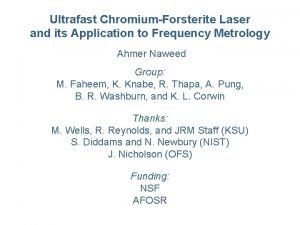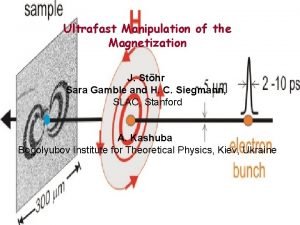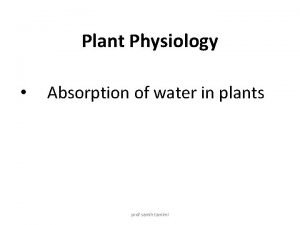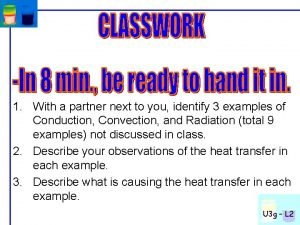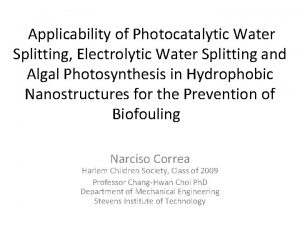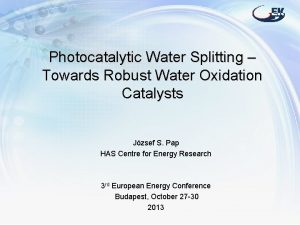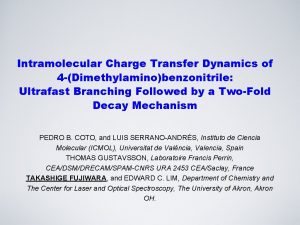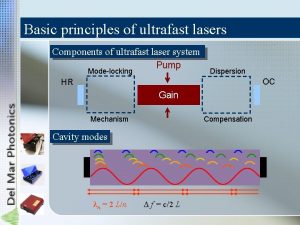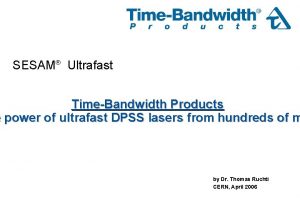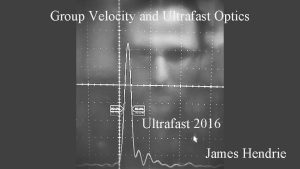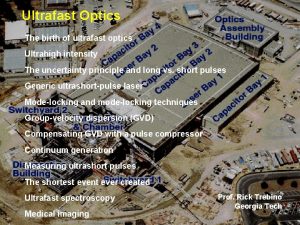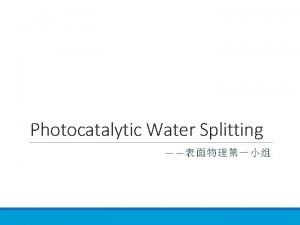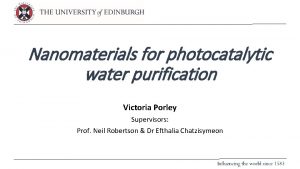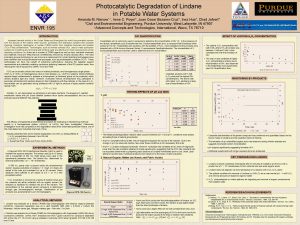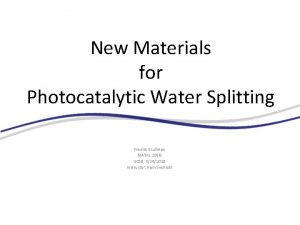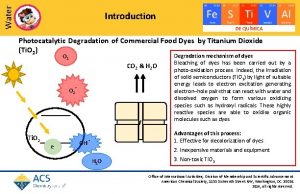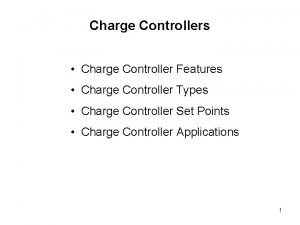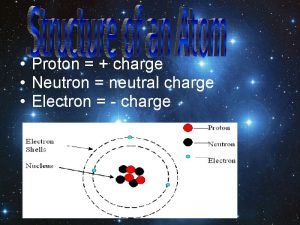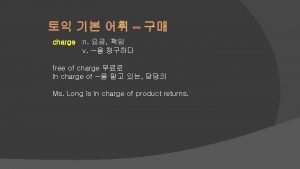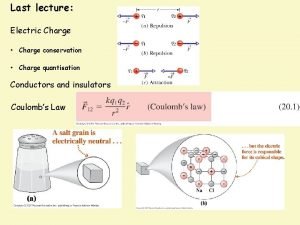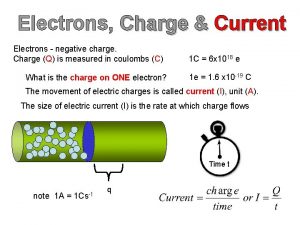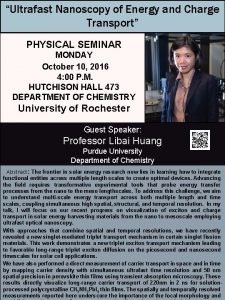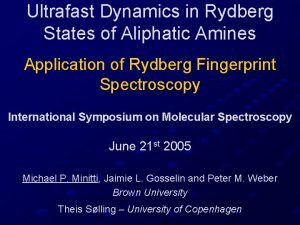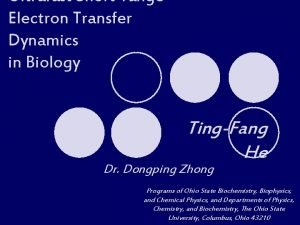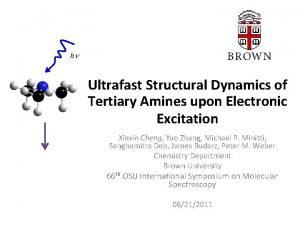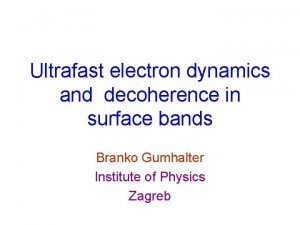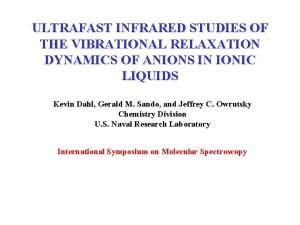Role of Ultrafast Charge Dynamics in Photocatalytic Water



![Heterogeneous Catalysis Helmholtz Double Layer Dynamic Catalytic Surface Suggested First Hole Transfer (t=0): [h+] Heterogeneous Catalysis Helmholtz Double Layer Dynamic Catalytic Surface Suggested First Hole Transfer (t=0): [h+]](https://slidetodoc.com/presentation_image/3b88687adfc1da28fb752a39b929eb2f/image-4.jpg)













![Possible Intermediate Species Formed [h+] + [OH-] k 1 [OH*] k 1” [-OOH or Possible Intermediate Species Formed [h+] + [OH-] k 1 [OH*] k 1” [-OOH or](https://slidetodoc.com/presentation_image/3b88687adfc1da28fb752a39b929eb2f/image-18.jpg)

![Transient Grating Diffraction I/I = R(t)cos( (t)) + TG(t)cos [ - (t)] Recombination (t) Transient Grating Diffraction I/I = R(t)cos( (t)) + TG(t)cos [ - (t)] Recombination (t)](https://slidetodoc.com/presentation_image/3b88687adfc1da28fb752a39b929eb2f/image-20.jpg)













- Slides: 33

Role of Ultrafast Charge Dynamics in Photocatalytic Water Oxidation Nanotek, December 2014 Tanja Cuk Assistant Professor, Chemistry, UCB Faculty Scientist, CSD, LBNL

Transient Optical, Infrared Spectroscopy Fuel Transient X-Ray Spectroscopy H 2 O , CO 2 + H 2 O + h FUEL + O 2 Controlling Charge Flow Heterogeneous Catalysts

Water Oxidation Catalysts: Transition Metal Oxides 4 h+ + 2 H 2 O O 2 + 4 H+ Hydroxilated Surfaces E 0 = 0. 6 V vs. Ag/Ag. Cl Robust Catalysis Fe 2 O 3 Bluhm, Salmeron, Nilsson et. al. , J. Phys. Chem. C (2010) • Efficient and Sustainable Catalysis on TM Oxide Surfaces • Hydroxilated surfaces common to TM Oxide Surfaces
![Heterogeneous Catalysis Helmholtz Double Layer Dynamic Catalytic Surface Suggested First Hole Transfer t0 h Heterogeneous Catalysis Helmholtz Double Layer Dynamic Catalytic Surface Suggested First Hole Transfer (t=0): [h+]](https://slidetodoc.com/presentation_image/3b88687adfc1da28fb752a39b929eb2f/image-4.jpg)
Heterogeneous Catalysis Helmholtz Double Layer Dynamic Catalytic Surface Suggested First Hole Transfer (t=0): [h+] + [OH-] [OH*] Activation Barrier thru Transient Spectroscopy

Challenges in Applying Ultrafast Spectroscopy to Catalysis • Interplay of recombination and interfacial charge transfer • Sensitivity to the surface • Studying hetero-junctions (solid-solid, solid-liquid) • Multi-electron transfer processes and “clocking” the cycle

Strategy and Techniques Counter electrode Working electrode Reference electrode h+ h+ h+

Catalysts Devices Under Investigation n-type SC/Liquid Schottky Barrier 10 O 2/site-s n-Sr. Ti. O 3, High Over-Potential n-p Ga. As photodiode/Co 3 O 4 Hetero-junction 0. 01 O 2/site-s Co 3 O 4 , Low Over-Potential

Photo-electrochemistry of n-Sr. Ti. O 3 High Quantum Efficiency with 1 k. Hz Laser (W ) VRB • Single 150 fs Pulse Triggers Multi-electron Transfer Water Oxidation • Achieve high quantum efficiency (75%) under laser excitation

Transient Reflectance of n-Sr. Ti. O 3 Pump Band Gap, Probe Holes Surface Sensitivity Thru Reflectivity UV-VIS Ellipsometry Experimental conditions needed to probe k. CT , [h] : W = PUMP = PROBE Width of Electric Field at High Q. E. : W 25 nm Pump Band Gap (300 nm, 4 e. V): = /4 k 24 nm Probe Hole Absorption (800 nm, 1. 5 e. V): REFL = /4 n 27 nm

Interfacial Charge Transfer Sr. Nb 0. 001 Ti. O 3 (0. 1%) Sr. Nb 0. 007 Ti. O 3 (0. 7%) W = 25 nm pump , probe 24 nm W = 9 nm pump , probe 24 nm Change in kinetics reflects k. CT, [h]

Manipulating Interfacial Charge Transfer Sr. Nb 0. 001 Ti. O 3 (0. 1%) • Interfacial charge transfer rate increases with increasing oxidative voltages • Rate changes while current and quantum efficiency constant

Kinetics (V) • Kinetics are fit to a single exponential at early time scales • Rate constant depends exponentially on applied V (Arrhenius Law) M. Waegele, X. Chen, D. Herlihy, T. Cuk, JACS 2014

Voltage Distribution at the Surface CSC CH UH CH UFB + U = UH + USC U OH-/OH CB CSC UFB USC VB UH U = applied voltage

UH(V): Changing Surface Hole Potential (1) U + UFB = UH + USC (2) UH = (qsc + qphoto) / CH UH(0) = 0. 65 V give CH = 21 u. F/cm 2 n-Sr. Ti. O 3 Electrolyte UH(0) VB η(V) UH(V) Brockeris, Bard, Bocarsly

Activation Barrier of First Hole Transfer k = k 0 exp ( G*/4 k. BT) k = k 0 exp ( FUH / RT) h+ OH* αe 0∆UH(V) [h+] + [OH-] k [OH*] α = 0. 2 ± 0. 05 e 0 UH k 0 = 7 x 10 -7 ps-1 ( s) e 0ΔUH(V) [From Photoemission, 1. 2 V] Quantifies barrier to localizing VB hole onto a molecular O 2 p bond

Conclusions • Quantified interfacial charge transfer at n-type semiconductor/liquid interface • Activation barrier (α, k 0) for first hole transfer of water oxidation reaction in n-Sr. Ti. O 3 Next Steps • Next step on n-Sr. Ti. O 3: concomitant intermediates using ultrafast infrared spectroscopy • Investigate lower over-potential catalysts, and other ntype semiconductors stable in aqueous solutions (e. g. Ga. N)

Acknowledgements Graduate Students Hoang Doan Stephanie Choing Postdoc Kevin Pollack Matthias Waegele David Herlihy Xihan Chen Jonathon Radberg Aayush Singh (Undergraduate) Joseph Mosley (Volunteer) Funding CPIMS Program AFOSR Young Investigator (Co 3 O 4) Facilities/Discussions Heinz Frei Steve Leone Gabor Somorjai Eli Yablonovitch Ian Sharp (JCAP) Joel Ager (JCAP) Michelle Chang
![Possible Intermediate Species Formed h OH k 1 OH k 1 OOH or Possible Intermediate Species Formed [h+] + [OH-] k 1 [OH*] k 1” [-OOH or](https://slidetodoc.com/presentation_image/3b88687adfc1da28fb752a39b929eb2f/image-18.jpg)
Possible Intermediate Species Formed [h+] + [OH-] k 1 [OH*] k 1” [-OOH or -OOTi] • -OOH is a likely intermediate: ms-FTIR (Frei) • Single rate constant (k 1) implies a highly populated –OOH surface? • Probe nature of OH* (or O*) as surface trap (transient XAS) k 1” k 1

Ultrafast Transient IRRAS Transient -SCN / -NSC at n-Sr. Ti. O 3 Decays with n-Sr. Ti. O 3 Free Carriers 2 ps • Small molecule rotations/bindings (-SCN, -NCS) • Reaction Intermediate Rise Times • Effects of surface potential/electric field vs. charge transfer
![Transient Grating Diffraction II Rtcos t TGtcos t Recombination t Transient Grating Diffraction I/I = R(t)cos( (t)) + TG(t)cos [ - (t)] Recombination (t)](https://slidetodoc.com/presentation_image/3b88687adfc1da28fb752a39b929eb2f/image-20.jpg)
Transient Grating Diffraction I/I = R(t)cos( (t)) + TG(t)cos [ - (t)] Recombination (t) = R(t)cos( (t)) Diffusion (t) = TG(t)/R(t) = exp (-Dq 2/t) Heterodyne Detection: TG(t), R(t), (t) determined by varying , probe-ref phase

Catalysts Devices Under Investigation n-type SC/Liquid Schottky Barrier 10 O 2/site-s n-Sr. Ti. O 3, High Over-Potential n-p Ga. As photodiode/Co 3 O 4 Hetero-junction 0. 01 O 2/site-s Co 3 O 4 , Low Over-Potential

- Co 3 O 4 p-Ga. As n+-Ga. As Transient Reflectivity on Hetero. Pump Fromjunctions Back, Probe From Front at Open Circuit Probe depth e R h h INJECT + + + + • Charge separation spatially separated from hole injection into catalyst • Ultrafast charge injection ( 10 ps) unimpeded by slow diffusion kinetics • Can recombination kinetics in Ga. As & hole kinetics in Co 3 O 4 be separated in a transient reflectivity experiment?

Kinetics of Holes in Catalyst Overlayer ~0. 5 m. J/cm 2 Hole injection Ga. As Ir. O 2 PVD Co 3 O 4 ALD Co 3 O 4 Sputt • Surface sensitivity of ∆R w/ 400 nm probe • Kinetics vary w/ catalyst type • Strong signal of surface holes with catalyst • Also with deposition technique • Time delay for hole injection (~10 ps) • Reproducibility for same batch

Hole Carriers as an antenna to THz? ~5 m. J/cm 2 τmobile holes 0. 87 THz 0. 87, 0. 44 THz • 0. 8 THz (& w/ 0. 4 THz) signal generated from catalyst over-layer, independent of catalyst type • Strength and decay of THz signal depends on catalyst type and deposition technique • Potentially, mobile holes responding to THz in Ga. As that decay to surface trapped states THz Generation - p-Ga. As THz Antenna + + + Plasma frequency of p-dopants responding to E field Effects of Electrolyte? Free Carriers Injected in Catalyst Responding to THz field

Conclusions • Activation barrier (α, k 0) for first hole transfer of water oxidation reaction in n-Sr. Ti. O 3 • Next steps n-Sr. Ti. O 3: (1) concomitant intermediates using ultrafast infrared spectroscopy, (2) transient diffraction gratings for interfacial hole diffusion • Ultrafast photodiode for low over-potential catalysts: dynamics of charge-separated carriers at electrolyte interfaces

Acknowledgements Graduate Students Hoang Doan Stephanie Choing Postdoc Kevin Pollack Matthias Waegele David Herlihy Xihan Chen Jonathon Radberg Aayush Singh (Undergraduate) Joseph Mosley (Volunteer) Funding CPIMS Program AFOSR Young Investigator (Co 3 O 4) Facilities/Discussions Heinz Frei Steve Leone Gabor Somorjai Eli Yablonovitch Ian Sharp (JCAP) Joel Ager (JCAP) Michelle Chang

Reaction via surface hole (valance band oxygen)

Reaction via hot hole (surface axial oxygen)

Number of surface site calculation 1. Sr. Ti. O 3 has a lattice constant of a=3. 905 A 2. (1, 0, 0) surface for Sr. Ti. O 3 is cubic, which looks like the graph on the right 3. Each (1, 0, 0) lattice has 3 surface atoms(1 Ti, 2 O) 4. Therefore, each lattice has area of A=a 2=1. 525*10^-15 cm 2 5. Surface atom density=# of atoms on one lattice surface/lattice surface area So, surface atom density= 3/1. 525*10^-15 cm 2 = 1. 967*10^15 atoms/cm 2

Voltage Distribution (Dark, Equilibrium) Mott-Schottky: UFB = 1. 6 V Photo-Voltage: UOC = USC = 0. 85 V • Photo-voltage at open circuit roughly half of UFB • UH= 0. 65 V in the dark, at equilibrium (no applied U)

Voltage Distribution (Illumination) Capacitance Illuminated Junction qsc qphoto CB VB n-type Reverse Bias p-type Forward Double Bias Layer Turner, Nozik APL 37 (1980) • Photo-induced holes at interface create an interfacial p-type layer • This interfacial “carrier inversion” changes UH, even with no applied U

SEM images a)-d) show damage on 0. 1% Nb doped Sr. Ti. O 3 under laser and applied bias condition a) b) a) 10μm c) c) d) 1μm 1. 2. 3. 4. 10μm a) b) c) d) Damaged sample at 1500× magnification Damaged sample at 3500× magnification Undamaged sample at 1500× magnification SEM image shows laser burned holes on sample surface, most of the holes have 5 um as diameter while some big holes have 10 um as diameter No damage is observed if only laser is applied to our sample, damage happens when current is running through the sample and laser is applied. Laser spot size is 500 um(FWHM) but the peak is narrow around 10 um One possible mechanism for the damage is coulomb explosion where high density of excitons generated by laser accumulate at sample surface causes explosion

Water Oxidation Over-Potential Thermodynamic potential, High kinetic barriers ~ 0. 01 O 2 /site-sec High over-potential, Lower kinetic barriers ~10’s O 2 /site-sec How do the surface dynamics modify the kinetic barriers and thermodynamics of each intermediate in the cycle?
 Ultrafast
Ultrafast Ultrafast demagnetization
Ultrafast demagnetization Ultrafast magnetism
Ultrafast magnetism Water and water and water water
Water and water and water water Difference between charge and electric charge
Difference between charge and electric charge Electrons flowing
Electrons flowing C# azure worker role example
C# azure worker role example Krappmann modell
Krappmann modell Statuses and their related roles determine the structure
Statuses and their related roles determine the structure Structural dynamics of deep water offshore wind turbines
Structural dynamics of deep water offshore wind turbines Solar dynamics water heater
Solar dynamics water heater Significance of transpiration
Significance of transpiration Balneal role of water
Balneal role of water Drinking fountain
Drinking fountain Dock water
Dock water How can we reuse water for class 3
How can we reuse water for class 3 Alberto rode 5/8 of the water rides at a water park
Alberto rode 5/8 of the water rides at a water park Class 8 english chapter 7 water water everywhere
Class 8 english chapter 7 water water everywhere Water to water heat exchanger
Water to water heat exchanger Fresh water meets salt water
Fresh water meets salt water Warm water rises in a lake. cold water descends.
Warm water rises in a lake. cold water descends. Clil water
Clil water Water resources
Water resources Unit 11 water water everywhere
Unit 11 water water everywhere Wholesale sat nav
Wholesale sat nav What a wonderful world dynamics
What a wonderful world dynamics Structure and dynamics of personality
Structure and dynamics of personality Dynamics gp miami
Dynamics gp miami Mark rockwell rockton software
Mark rockwell rockton software Crm user group
Crm user group Gamification dynamics 365
Gamification dynamics 365 Riva crm integration reviews
Riva crm integration reviews 4 groups of people
4 groups of people Student relationship management
Student relationship management
